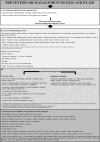Sports Dietitians Australia and Ultra Sports Science Foundation Joint Position Statement: A Practitioner Guide to the Prevention and Management of Exercise-Associated Gastrointestinal Perturbations and Symptoms
- PMID: 40195264
- PMCID: PMC12106582
- DOI: 10.1007/s40279-025-02186-6
Sports Dietitians Australia and Ultra Sports Science Foundation Joint Position Statement: A Practitioner Guide to the Prevention and Management of Exercise-Associated Gastrointestinal Perturbations and Symptoms
Abstract
It is now well-established that exercise can disturb various aspects of gastrointestinal integrity and function. The pathophysiology of these perturbations, termed "exercise-induced gastrointestinal syndrome (EIGS)," can lead to exercise-associated gastrointestinal symptom (Ex-GIS) inconveniences. EIGS outcomes can impact physical performance and may lead to clinical manifestation warranting medical intervention, as well as systemic responses leading to fatality. Athlete support practitioners seek prevention and management strategies for EIGS and Ex-GIS. This current position statement aimed to critically appraise the role of EIGS and Ex-GIS prevention and management strategies to inform effective evidence-based practice and establish translational application. Intervention strategies with mostly consistent beneficial outcomes include macronutrient (i.e., carbohydrate and protein) intake and euhydration before and during exercise, dietary manipulation of fermentable oligo-, di-, and mono-saccharides and polyols (FODMAP), and gut training or feeding tolerance adjustments for the specific management of Ex-GIS from gastrointestinal functional issues. Strategies that may provide benefit and/or promising outcomes, but warrant further explorations include heat mitigating strategies and certain nutritional supplementation (i.e., prebiotics and phenols). Interventions that have reported negative outcomes included low-carbohydrate high-fat diets, probiotic supplementation, pharmaceutical administration, and feeding intolerances. Owing to individual variability in EIGS and Ex-GIS outcomes, athletes suffering from EIGS and/or support practitioners that guide athletes through managing EIGS, are encouraged to undertake gastrointestinal assessment during exercise to identify underlying causal and exacerbation factor/s, and adopt evidence-based strategies that provide individualized beneficial outcomes. In addition, abstaining from prevention and management strategies that present unclear and/or adverse outcomes is recommended.
© 2025. The Author(s).
Conflict of interest statement
Declarations. Funding: No funding was provided for this review. Conflicts of Interest: Costa, Gaskell, and Snipe have contributed to the development of exercise gastroenterology educational material previously presented on the Future Learn online learning platform, targeting health and exercise professionals, as part of Monash University continued professional development educational packages. Costa is currently responsible for the delivery and management of educational resources in the training of sport and exercise professionals supporting athletes with gastrointestinal issues within national sport institutes and professional sports clubs. Costa is the lead of the Monash University Exercise & Nutrition Clinic that offers specialized gastrointestinal assessment services to athletes with clinical justification. Costa and Scheer are members of the USSF scientific committee. Costa is a member of the SDA education committee. Costa, Gaskell, Henningsen, Jeacocke, Martinez, Scrivin, Snipe, and Young are members of SDA. RC was the chief investigator of two EIGS prevention or management strategy research projects that received funding from commercial industry collaborators [136, 184]. All funding and conflicts of interest regarding these original studies are fully disclosed in the original publication. All other authors have no other conflict of interest to declare. Availability of Data and Materials: Data and materials presented within this review can be made available by contacting the corresponding author, at reasonable request. Ethics Approval: Not applicable. Author Contributions: Authors contributions, which included exploration of the topic area literature using a scoping review approach, critical evaluation of referenced studies’ methodological application against best-practice checklist (Costa et al., 2022), level of evidence proposal, practical application, and/or initial text draft of section, are as follows and based on track record (research and practice) in the specific topic: background, R.C.; exercise-induced gastrointestinal syndrome (EIGS), R.C.; exercise-associated gastrointestinal symptoms (Ex-GIS), R.Sc.; EIGS and Ex-GIS exacerbation factors, R.C.; methodological considerations, R.C.; macronutrients and equivalents, R.Sn. and R.C.; dietary strategies, S.G., R.Sc., A.W., and R.C.; nutritional supplements, K.H., P.Y., and R.C.; hydration, R.C.; heat mitigating strategies, R.Sn.; gut training, I.M.; feeding tolerance (supplementary file 1), R.C.; other considerations (supplementary file 2), A.M. and R.C.; and translational application (supplementary file 3), S.G., N.J., and V.S. R.C. compiled sections and levels of evidence. All authors reviewed and approved the compiled sections and grade of evidence. All authors read and approved the final version. Informed Consent: Not applicable.
Figures


Comment in
-
Comment on: "Sports Dietitians Australia and Ultra Sports Science Foundation Joint Position Statement: A Practitioner Guide to the Prevention and Management of Exercise-Associated Gastrointestinal Perturbations and Symptoms".Sports Med. 2025 Nov;55(11):2933-2935. doi: 10.1007/s40279-025-02274-7. Epub 2025 Jul 29. Sports Med. 2025. PMID: 40730939 No abstract available.
References
-
- Gordon B, Levine SA, Wilmaers A. Observations on a group of marathon runners: with special reference to the circulation. Arch Intern Med. 1924;33(4):425–34. 10.1001/archinte.1924.00110280023003.
-
- Costa RJS, Snipe RMJ, Kitic CM, Gibson PR. Systematic review: exercise-induced gastrointestinal syndrome-implications for health and intestinal disease. Aliment Pharmacol Ther. 2017;46(3):246–65. 10.1111/apt.14157. (Epub 20170607). - PubMed
-
- Brouns F, Saris WH, Rehrer NJ. Abdominal complaints and gastrointestinal function during long-lasting exercise. Int J Sports Med. 1987;8(3):175–89. 10.1055/s-2008-1025653. - PubMed
-
- Rehrer NJ, Beckers E, Brouns F, ten Hoor F, Saris WH. Exercise and training effects on gastric emptying of carbohydrate beverages. Med Sci Sports Exerc. 1989;21(5):540–9. - PubMed
Publication types
MeSH terms
LinkOut - more resources
Full Text Sources
Medical

